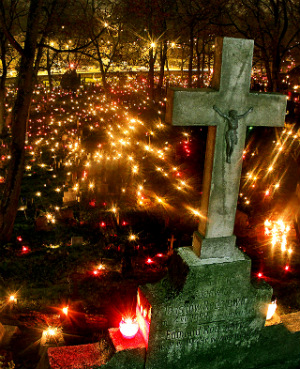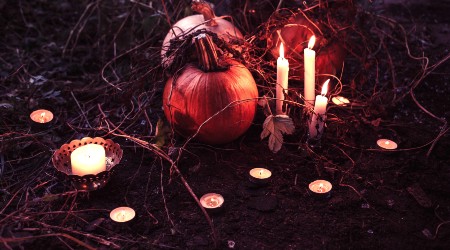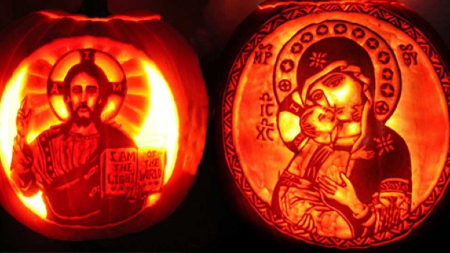We ask you, humbly: don't scroll away.
Hi readers, it seems you use Catholic Online a lot; that's great! It's a little awkward to ask, but we need your help. If you have already donated, we sincerely thank you. We're not salespeople, but we depend on donations averaging $14.76 and fewer than 1% of readers give. If you donate just $5.00, the price of your coffee, Catholic Online School could keep thriving. Thank you.Help Now >
Fractio Panis
FREE Catholic Classes
(BREAKING OF BREAD.)
The name given to a fresco in the so-called "Capella Greca" in the catacomb of St. Priscilla situated on the Via Salaria Nova. The fresco, which with the whole of the decorations of the chapel dates from the first half of the second century, is of the highest liturgical and theological importance. The painting is found upon the face of the arch immediately over the altar tomb, upon which beyond all reasonable doubt the Holy Sacrifice was offered. By a providential accident this particular fresco, having been covered by a thick crust of stalactites, escaped the notice of the early explorers of the catacombs, who, by their eagerness and ignorance combined, often did much irreparable harm. In the year 1893, Mgr. Joseph Wilpert, the most distinguished of a band of young scholars who looked upon the great archaeologist De Rossi as their master, arrived at the conclusion that the roof and arches of this chapel were decorated with frescoes. Chemical reagents were used to remove the crust which covered the surface, and by the patient care of Mgr. Wilpert this delicate operation was attended with complete success. The most important fresco thus recovered was that already referred to over the altar tomb. The scene represented is a picture of seven persons at table, six men and a woman. It seems clear that six of these are reclining as the ancients reclined at their meals. But the seventh personage, a bearded and impressive figure, sits somewhat apart at the extremity of the table in an attitude which is highly significant. His head is thrown back, he has a small loaf or cake in his hands, and his arms stretched out in front of him show that he is breaking it. Upon the table immediately before him is a two-handled cup. Further along the table there are two large plates, one containing two fishes, the other five loaves. At each extremity of the picture upon either side we notice baskets filled with loaves--four baskets at one end, three at the other.
As a very little reflection will suffice to prove, no doubt can be felt as to the significance of the scene. It depicts beyond question that striking Eucharistic act, "the breaking of the bread" ( klasis tou artou -- fractio panis), which seems to have so much impressed our Lord's immediate disciples. The phrase itself at once transports us back to the very beginnings of Christianity. No wonder that De Rossi, whose last years were gladdened by this find, described it as "the pearl of Catacomb discoveries". To point out briefly how constantly this phrase "fractio panis" recurs in early Christian literature, we may note that not only is the "blessing and breaking " of the bread mentioned in each of the four accounts of the Last Supper, but repeatedly also in the other Apostolic writings. For example in 1 Cor, x 16, "The chalice of benediction, which we bless, is it not the communion of the blood of Christ? And the bread, which we break, is it not the partaking of the body of the Lord?" So again in Acts, ii, 42, "And they were persevering in the doctrine of the apostles and in the communication of the breaking of bread, and in prayers " (cf. Acts 2:46 ). And particularly Acts, xx, 7, "And on the first day of the week , when we were assembled to break bread", where this practice is closely associated with the observance of Sunday. (Cf. also the disciples at Emmaus on Easter day -- Luke 24:30, 35 , and Acts 27:35 ). Similar prominence is given to this conception in other sub-Apostolic writings, notably in the Didache or "Teaching of the Apostles" (xiv, I), where it is associated with the observance of the Sunday as well as with the explicit mention of Sacrifice and with confession. "And on the Lord's day come together and break bread and give thanks, having first confessed your transgressions, that your sacrifice may be pure." Further, in ch. xi of the same early treatise the consecrated Host is clearly designated by the term klasma , i.e. "broken bread". Nothing then could be more natural than that, in the earliest form of the liturgy, the breaking of the bread should have been regarded as the climax of the ritual employed and should have been for the early Christians what the Elevation in the Mass is nowadays for us. Moreover this Eucharistic significance of the picture is borne out by all the accessories. The loaves and the fishes upon the table point directly to the miraculous multiplication twice performed by Christ. The association of this miracle with the Blessed Eucharist is familiar, not only in other archaeological monuments, but also in early Christian literature. See for example Origen, "In Matt.", x, 25 (P.G. XIII, 902), and Ambrose, "De Virgin.", I, 3 (P.L., XVI, 219). Upon the symbolic significance of the fish and the anagram ichthys , it cannot be necessary to insist. Both the inscription of Abercius (q.v.) of the close of the second century and that of Autun a little later, as well as the large number of allusions in early Christian literature, make it clear that our Saviour Jesus Christ was indicated by this symbol (see e.g. Mowat in the "Atti del Congresso Internnaz. d'Archeol. Crist.", Rome, 1902, pp. 2-4) Moreover, the Abercius inscription clearly conveys that this "great fish" was to be the permanent food of the soul. We may also note that the one female fixture among the guests depicted in the Fractio Panis fresco is veiled which is not the case with the female figures represented in those other banqueting scenes found in the catacombs and usually interpreted as symbolic of the joys of heaven. The fresco of which we speak is not, as will be readily understood, either entirely realistic or entirely symbolical. That the president ( proestos ) of the synaxis (assembly) should break the bread seated, is probably not to be understood as implying that the bishops in the primitive church were in fact seated when they offered the liturgy any more than the attitude of the guests implies that the early Christians reclined on couches when they assisted at the Holy Sacrifice. On the other hand, the action of the breaking of the bread is clearly realistic. A further indication of the Eucharistic significance of the freseo here under discussion is afforded by the fact that in the fresco next to it in the same chamber is depicted the sacrifice of Abraham. On the other side is a representation of Daniel in the lions' den, to which Mgr. Wilpert also attaches a Eucharistic significance on account of the supernatural feeding of Daniel through the intervention of the prophet Habacuc (Dan., xiv, 36).
Join the Movement
When you sign up below, you don't just join an email list - you're joining an entire movement for Free world class Catholic education.
-

-
Mysteries of the Rosary
-
St. Faustina Kowalska
-
Litany of the Blessed Virgin Mary
-
Saint of the Day for Wednesday, Oct 4th, 2023
-
Popular Saints
-
St. Francis of Assisi
-
Bible
-
Female / Women Saints
-
7 Morning Prayers you need to get your day started with God
-
Litany of the Blessed Virgin Mary
All Saints' Day, Halloween and All Souls' Day: What's the difference?
-

Should Christians Celebrate Halloween?
-

Since when did Halloween become a Christian holiday?
-
ADORABLE: A Little Boy's Heartfelt Lunchtime Prayer
-
Scientists Decode 3,000-Year-Old Babylonian Tablet, Revealing Potential Location of Noah's Ark
Daily Catholic
 Daily Readings for Friday, November 01, 2024
Daily Readings for Friday, November 01, 2024 St. Valentine Berrio-Ochoa: Saint of the Day for Friday, November 01, 2024
St. Valentine Berrio-Ochoa: Saint of the Day for Friday, November 01, 2024 Litany of the Saints: Prayer of the Day for Friday, November 01, 2024
Litany of the Saints: Prayer of the Day for Friday, November 01, 2024- Daily Readings for Thursday, October 31, 2024
- St. Wolfgang: Saint of the Day for Thursday, October 31, 2024
- Memorare: Prayer of the Day for Thursday, October 31, 2024
![]()
Copyright 2024 Catholic Online. All materials contained on this site, whether written, audible or visual are the exclusive property of Catholic Online and are protected under U.S. and International copyright laws, © Copyright 2024 Catholic Online. Any unauthorized use, without prior written consent of Catholic Online is strictly forbidden and prohibited.
Catholic Online is a Project of Your Catholic Voice Foundation, a Not-for-Profit Corporation. Your Catholic Voice Foundation has been granted a recognition of tax exemption under Section 501(c)(3) of the Internal Revenue Code. Federal Tax Identification Number: 81-0596847. Your gift is tax-deductible as allowed by law.







 Daily Readings for Friday, November 01, 2024
Daily Readings for Friday, November 01, 2024 St. Valentine Berrio-Ochoa: Saint of the Day for Friday, November 01, 2024
St. Valentine Berrio-Ochoa: Saint of the Day for Friday, November 01, 2024 Litany of the Saints: Prayer of the Day for Friday, November 01, 2024
Litany of the Saints: Prayer of the Day for Friday, November 01, 2024

